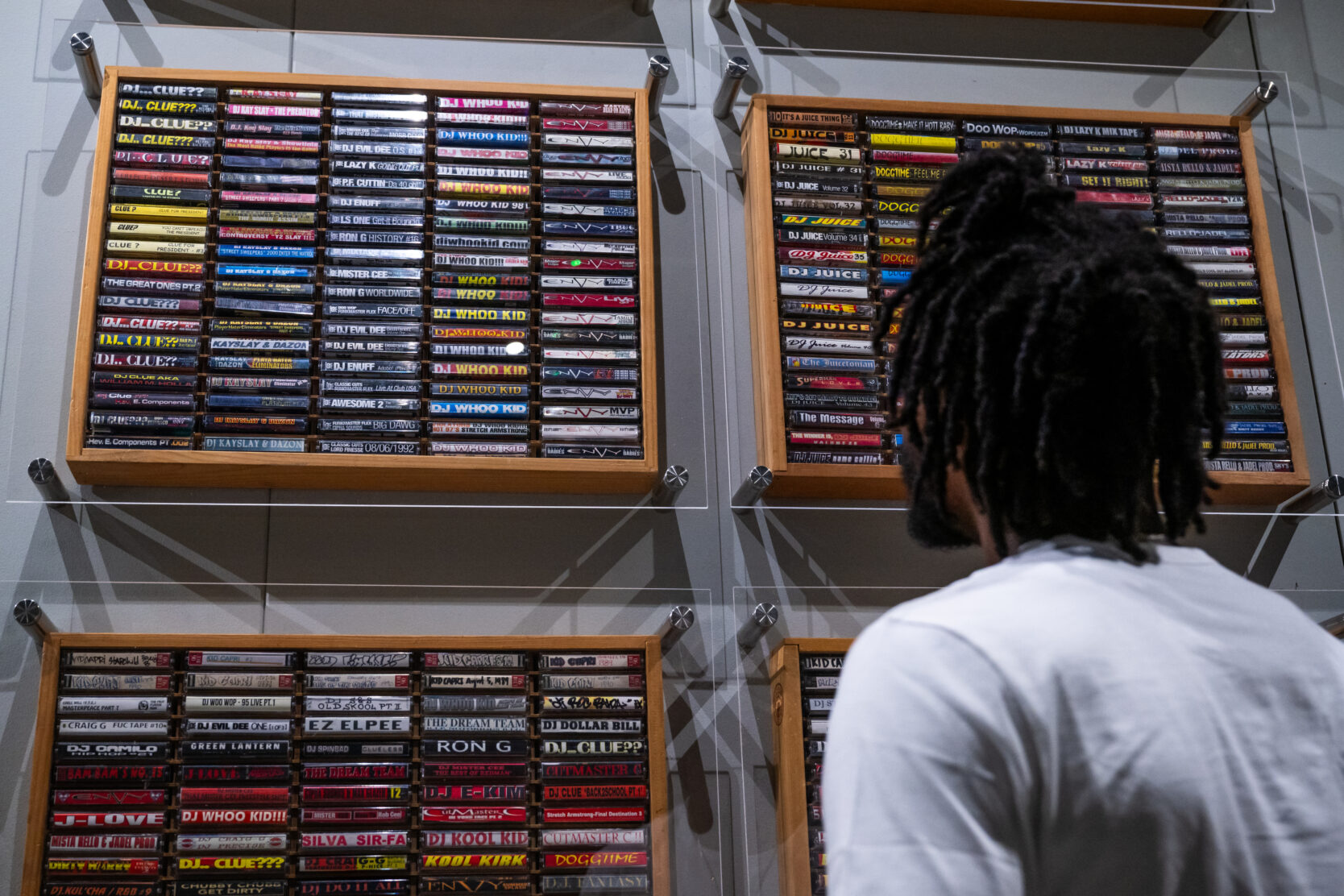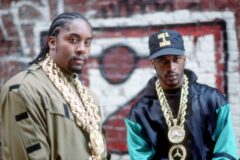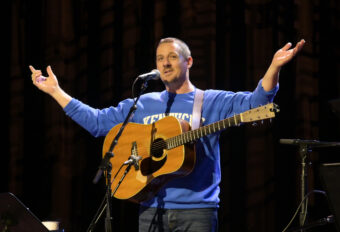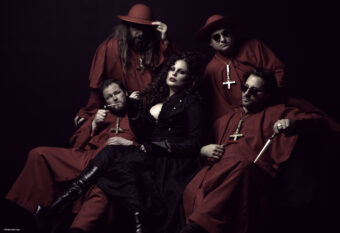In 2024, rap music and hip-hop culture are almost inextricable from the commercial record industry. Created and incubated by people on the socioeconomic margins and firmly outside of the mainstream, rap made the leap from the parks and rec centers of the Bronx to the recording studio and eventually the Billboard charts with Sugar Hill Gang’s genre-defining smash, “Rapper’s Delight.” Once the music of the street became available to buy in the record store, any hope of separating hip-hop’s identity from the music business became nearly impossible. Despite this, hip-hop owes much of its early development and propagation to an underground economy that the record industry didn’t understand or capitalize on. In the years before rap made it to wax, the recording and circulation of cassette tapes of park jams, live battles, DJ sets, and radio broadcasts were the only way to hear the music.
The Cassette Tape and the Birth of Hip-Hop
The cassette tape was invented in 1963 by engineer Lou Ottens. He intended to create a small, compact and portable alternative to reel-to-reel tape, but in the hands of consumers, the cassette tape would become much more. With a dual tape deck recorder, a duplicate copy of any cassette can be copied onto a blank tape, allowing for commercial recordings to be easily shared and bootlegged. Ironically, the peer-to-peer sharing of cassette tapes would play a significant role in the documentation and spread of the next big juggernaut in commercial music; hip-hop.
Today, the story of hip-hop’s inception is widely known. On August 11, 1973, a young woman named Cindy Campbell organized a party in the rec room of a housing complex at 1520 Sedgwick Avenue in the Bronx. Cindy recruited her brother Clive “Kool Herc” Campbell, to DJ at the event. Despite Herc’s relatively low profile at the time, his party would retroactively be acknowledged as ground zero for the cultural movement that would later be known as hip-hop.
While it would be impossible to estimate how many tapes were in circulation in hip-hop early years, a handful have been preserved and now hold legendary status amongst listeners. Tapes like Kool Herc’s 1978 battle with the L Brothers at Bronx River Center and the Cold Crush Brothers vs. the Fantastic Five at Harlem World, Bambaataa’s Death Mix, the Furious Five’s live version of “Flash It To The Beat” and others captured the sound of those crucial years before the music completely broke into the mainstream.
Geechie Dan is an artist, archivist and prolific collector of old-school hip-hop tapes. With over 1,000 cassettes in his collection, Dan’s archive of tapes includes the Cold Crush, Jazzy 5 and the infamous Kool Moe Dee Vs. Busy Bee Starski battle, recorded live at Harlem World’s Christmas Rappers Convention in 1981. Hearing DJs play disco records at park jams in Queens as a kid, Dan got to witness this formative period in NYC music history firsthand. It was around this time, he first started hearing the tapes that would ignite this lifelong passion.
“I was hearing DJ Hollywood and what he was doing at Club 371 in the Bronx,” he says. “And I heard Eddie Cheeba, Lovebug Starski started combining the disco crowd with the hip-hop crowd. And then I started hearing tapes of (*the inventor of turntable scratching) Grand Wizard Theodore, Grandmaster Flash, Furious Five, The L Brothers, Cold Crush Four.”
Thinking back to the seminal tapes that he acquired early in his days, Dan runs down a list of recordings that encapsulate the spirit of hip-hop’s first decade.
“The first tape that stuck out in my mind that really stuck out was the Cold Crush 4 at Harlem World. It was the Treacherous Three’s second anniversary in 1981.” (*this tape has since been uploaded to YouTube by collector Troy Smith). “That’s when I started really getting passionate about what I was hearing on the tapes. That one tape started everything and it was like a domino effect. And then I got the Kool Moe D. vs. Busy Bee battle. Soul Sonic Force Tapes, Zulu Nation tapes, then The Funky Four tapes. Everybody had their different flavor that they brought to the table.”
Taping Through the Five Boroughs
On the eve of hip-hop’s emergence as a commercial force, underground tapes of rap’s first wave of pioneers traveled well throughout New York. Writer and hip-hop historian, JayQuan has written extensively about how early recordings of parties and jams circulated throughout the city by way of independent car services. An affordable alternative to limousines and luxury car rentals, customers would call a number and book a car to come pick them up and drop them off at their location. DJs and members of hip-hop crews would provide drivers with tapes which the drivers would play in their cars as they traveled around the city. Customers would hear the tapes by DJ Hollywood, Cold Crush Brothers, Grandmaster Flash played in the cars and this helped spread the music far and wide. When asked about the New York car services, JayQuan explains that the car services and their drivers played a key role in propagating the sound of early hip-hop.
“The OJ Car service and services like Touch of Class and others, the drivers were young people and they had these tapes,” he says. “A lot of times they were second and third-generation copies. The person who recorded it had a decent copy. And I say decent because the boombox is sitting there (next to the speaker at a party). You got live air, people talking, somebody dropping something. You’re hearing everything. So, these drivers are driving around the boroughs in New York, and the tape is traveling.”
While the release of “Rapper’s Delight” signaled hip-hop’s arrival in the mainstream, it’s ironic that the song’s origins can be traced to an underground Grandmaster Caz tape. The story goes that one day, future Sugar Hill Gang member Big Bank Hank was working his shift at Crispy Crust Pizza in Edgewood, N.J. when record executive Sylvia Robinson entered the shop. Sylvia watched Hank lip-synch along to the tape that Caz gave him and asked him to audition for a group that she was putting together. Seeking to capitalize on rap music before it blew up, Robinson assembled the Sugar Hill Gang, and Hank’s verse on “Rapper’s Delight” was stolen word for word from Caz without credit or compensation. “Rapper’s Delight” would go on to be a smash hit, selling millions of copies since its release and influencing everything that came after it. With the commercial rap industry officially kicked into full gear, a wave of 12-inch singles made their way into record stores everywhere.
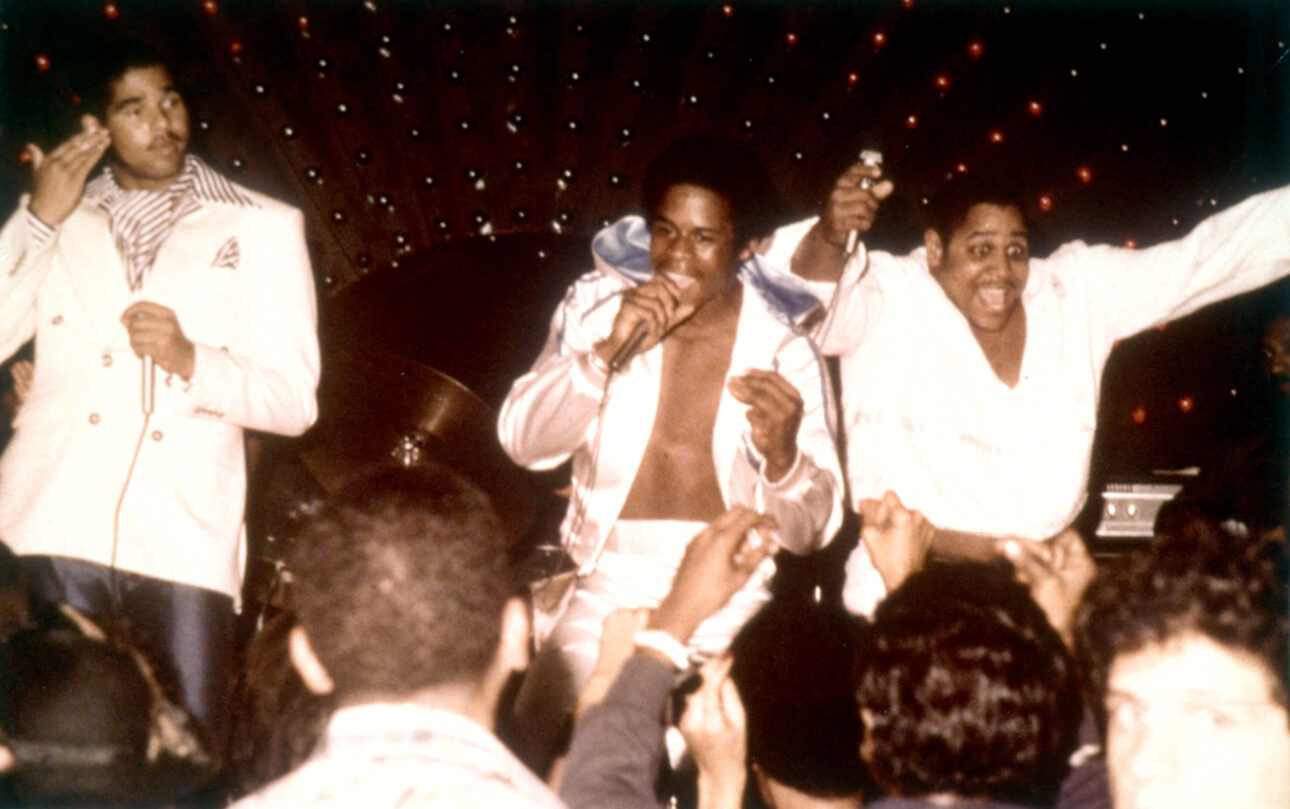
In 1979, records like Grandmaster Flash & The Furious Five’s “Superrappin,” Lady B’s “To The Beat Y’all,” Spoonie Gee’s “Spoonin Rap” and more. With a small handful of rap songs being made, live tapes of parties, battles, and DJ sets were still being made and distributed. The demand for these tapes created an underground economy that existed alongside rap’s commercial ascent.
Traveling Tapes and Hip-Hop’s National Growth
Elvis Moreno also known as “The Tapemaster” was the official recorder for the Cold Crush Brothers. In an Instagram post from 2022, Photographer Joe Conzo Jr. estimated that 75% of the tapes that we hear today from rap’s first generation were recorded by Moreno. Listening back to the Cold Crush tapes in particular, one gets a glimpse at the complexity and vitality of live hip-hop that couldn’t be fully captured in studio recordings. On a tape labeled 1982 Tape and uploaded to YouTube by Owen Small (UsbreaKs), the Cold Crush performed their “50 Ways to Rock the Party” routine. On this routine, the group reimagines the melody from Paul Simon’s “50 Ways to Leave Your Lover” and harmonizes over the break from Cerrone’s “Rocket in the Pocket.” It’s hard to imagine the kind of spontaneity and rawness displayed on these tapes translating to record. While the first wave of studio-recorded rap records played a vital role in introducing rap music to listeners worldwide, these cassette tapes also spread the sound of hip-hop’s first generation while retaining its original spirit.
Once hip-hop culture caught on outside the five boroughs, local scenes began to spring up in cities around the country. Similarly to New York in the late ‘70s and early ‘80s, the development of these regional hip-hop sounds can be heard through cassettes. Philadelphia, the first major market to embrace rap outside of New York, played an important role in hip-hop’s eventual growth into a nationwide cultural movement. Not only was Philly home to one of the earliest rap radio shows in the world when Lady B’s weekend rap show launched on WHAT in 1979, but it was also a popular touring stop for the first generation of rap artists. Philadelphia and the site of the first all-hip-hop nightclub, After Midnight, which changed to an all-rap format in 1984, one year before the Latin Quarter in Manhattan. As the site of so much activity during rap’s formative years, Philadelphia is an essential component for anyone seeking to understand hip-hop’s early development. Despite this, few tapes remain that document the city’s early scene. Jazzy Jeff & DJ Cash Money’s 1985 jam at the YMCA on 52nd Street (*Uploaded to SoundCloud by Hip-Hop Treasure Trove) and an explosive Grandmasters of Funk tape from 1983 featuring MC Parry P, Grand Tone and Kid Destroy playing a live drum machine (*Uploaded to YouTube by DJ DoubleKK).
In Los Angeles, a network of mixtape DJs played a vital role in introducing listeners to up-and-coming local rappers and the latest commercial hip-hop records from the East Coast. DJ Rhettmatic is an L.A. hip-hop veteran, turntablist and co-founder of the legendary Beat Junkies DJ crew. When asked about the role that mixtapes played in the development of hip-hop in Los Angeles, he points to the Roadium Swap Meet, a key distribution site for some seminal tapes in L.A.’s early scene.
“The Roadium Swap Meet is located in Gardena, which is part of L.A. County,” he says. “There was a Japanese-American record dealer over there named Steve Yano. He was selling records at the rodeo swap meet. He sold Dr. Dre the copies of Ultimate Breaks & Beats that he used on Straight Outta Compton and all the N.W.A.-related stuff. So I guess Steve would make deals with him like “Yo, make me a mixtape.“
Today, the tapes that Dre made for sale at Roadium Swap Meet can be heard on various YouTube and Mixcloud pages. Created on four-track cassette tape, Dre’s swap meet tapes are some of the most dynamic DJ mixes of the era. By recording to four-track, Dre was able to layer multiple blends and scratches on top of one another at a time, reaching a level of sonic density and complexity that was not possible with the traditional two turntables and a mixer setup. In 1987, Turntable Wizard Tony A took over the job of making the Roadium tapes with Dre and Eazy E still contributing vocals to Tony’s tapes which would prove to be highly influential to L.A.’s blossoming scene. The Roadium tapes, alongside tapes that were circulating in Philly, Memphis, Houston and cities around the country are artifacts through which the growth and evolution of our culture can be heard. Just as the invention of the cassette facilitated the creation and spread of these tapes, the internet would prove to be the next technological innovation that collectors would use to share hip-hop music.
Tape Trading and the Dawn of the Internet
On Oct. 2, 2000, hearings for the landmark case of A&M Records vs. Napster Inc. began in the United States Court of Appeals for the Ninth Circuit. Founded in 1999 by then-18-year-old programmer Shawn Fanning, Napster’s simple user model would prove to be revolutionary. By allowing music fans to share and download small, compressed digital copies of their favorite songs, Napster opened a Pandora’s box of sorts. Consumer acquisition of music was no longer reliant on the purchase of physical media. The labels argued that Napster allowed users to illegally copy copyrighted musical works, which users shared and downloaded widely for free. By 2001, Napster would file for bankruptcy and agree to settle with copyright holders, but not before peer-to-peer file sharing would radically alter the music business. Many listeners of Fanning’s generation grew up on an earlier form of peer-to-peer music sharing: tape trading.
Before Napster, MP3s and file-sharing completely changed the way music was discovered and distributed, hip-hop tape trading like punk and metal flourished on the internet. Collectors traded tapes via message boards and AOL chat groups. Collectors would agree on trades and send each other tapes in the mail with the entire process protected by the honor system. For anyone interested in getting an idea of what the hip-hop tape trading scene was like in the late ‘90s/early 2000s, the Dubmartian Swap Meet page is one of the few OG tape trading pages that is still online. Scrolling down the single-page site, one can peruse dozens of rare cassettes from West Coast underground stalwarts like Abstract Tribe Unique and Mystic Journeymen, demos, hard-to-find live recordings, and beyond.
At best, existing pages like Dubmartian Swapmeet are an interesting resource from a bygone era. Despite the recent resurgence in interest in physical media like vinyl records and cassettes, streaming is the medium that most consumers use to listen to music. This shift in culture and technology has all but eliminated the practice of tape trading on the scale that once existed. Fortunately, those vital tapes from hip-hop’s infancy have been preserved by a handful of dedicated collectors and many of them can be easily accessed through YouTube.
Constantly navigating music’s ever-changing landscape, Geechie Dan has launched an internet radio show called Planet of the Tapes. Airing on LL Cool J’s SiriusXM’s Rock the Bells channel, Dan’s show highlights key moments in hip-hop history by playing excerpts from his vast tape collection. Reflecting on the importance of the early hip-hop cassette tapes, Dan points to their immense impact in spreading the sound of hip-hop organically.
These tapes were circulated throughout the world. It started in the tri-state area and people got a glimpse of what was going on in New York.” Dan says. “And then they said, you know what? We don’t wanna sound like them. We wanna sound like how we sound in Compton, Miami, Houston. They got involved and started living the culture and making songs relative to their environment. I believe these tapes are the essence of hip hop.”

